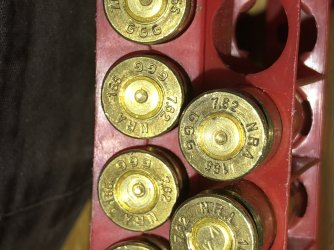MOA or bust
Well-Known Member
Thank you to Rflshootr and fseaman for helping this neophyte better understand ballistics.
 Help Support Long Range Hunting Forum
Help Support Long Range Hunting Forum
 These were reloads but factory ones were similar.
These were reloads but factory ones were similar.I kind feel you are on the right track about the primers being seated. Been proven wrong before. Have to watch this.Are your primers being seated properly: slightly below flush with the base? Peterson brass has tight primer pockets so if your not seating primers below flush I don't think the firing pin strike would have enough force to seat it leading to the primer being partially extruded when brass starts to flow.
Sure have, every load I have ever put through both barrels have gone over the Pressure Trace. Well within parameters of Max Pressure as by SAAMI.Then the only other thing that I can think of that would do it, other than excessive pressure, is the chamfer around the primer pocket letting the primer flow. I'd compare the chamfer on the Norma against the other brands.
Just curious, have you ever run a pressure trace on that rifle to see where it spikes?
My 28 Nosler Hells Canyon LR doesn't do that.All the primers I pop out of 28nos brass look like this. Factory ammo, reloads from the lower end to the top, doesn't seem to matter.
My 280AI doesn't do this. Is this just a 28nos thing? Wondering if this rifle needs to go back to the factory for a check-up. View attachment 620924View attachment 620925
You don't know that until you test with a no-go gaugeAlright, based on what I'm hearing from @Rflshootr and @fseaman , it sounds like the maybe the factory headspaced my chamber on the long end of the 5 thou tolerance so I can cram any old dirty ammo in there, so while I'm in spec and nothing going to blow up in my face , it's going to take several rounds to fire form my brass out before it's a cozy fit in my chamber. Until then, expect to see flattened primers.
A bit annoying, as this rifle seems to hit its node at bergers's max powder charge of 81 grains of Retumbo, but I feel like loading more toward the bottom end until the flat primers go away. Getting nervous about pressure signs leads to flinching (ask me how I know)
All barrels should have a barrel nut. Would be nice to screw the barrel in a few thou and save unnecessary rounds down the tube fire-forming brass. These noslers are not exactly known for long barrel life.
There's 5 thou between a go and no-go guage. I'm not saying it's out of spec, I'm saying that "spec" is a very broad range of values. If my brass needs to grow that much, I'm posturing that the rifle was headspaced toward the upper end of the allowable range. Is what it is, just wish I could tweak it a little to a tighter tolerance.You don't know that until you test with a no-go gauge
Go and no-go vary by maker. Not always .005". Good luckThere's 5 thou between a go and no-go guage. I'm not saying it's out of spec, I'm saying that "spec" is a very broad range of values. If my brass needs to grow that much, I'm posturing that the rifle was headspaced toward the upper end of the allowable range. Is what it is, just wish I could tweak it a little to a tighter tolerance.
The same reason I described in post #23. Factory ammo is short just like your new brass.Hornady OAL guage with the anvil base on a Mitutoyu caliper. De-prime, put it in the guage, wiggle/twist until the numbers settle down.
The brass isn't fire forming 5 thou. The shoulders might move forward 1-2thou after firing. So it would take several rounds of neck sizing only to fire-form. Will definitely admit that I had a bit of learning curve starting out, but the last time I loaded the brass started at 2.235 and fire-formed to 2.236 (virgin brass is 2.234, and if it fire-formed to fill the chamber it should be close to 2.240)
And why is it flattening factory ammo primers?
Add shims where?That's true and I know of 2 smiths that will add shims as to limits the bolt play to .001" in a precise action.
If you look at the SAMMI Specs, you will see that there is a chamber drawing and also an ammo drawing for each cartridge. The head space on the ammo is always shorter than the minimum head space on the chamber so it will always chamber. Both the chamber and the ammo has a minimum and maximum tolerance. So, and I'm not saying this is the case of your situation, but, it is possible that a chamber could be made to the long side of the tolerance, and the ammo could be made to the short side of the tolerance, which in that situation, the brass would have to grow much more to fill the chamber than if the chamber was on min and the ammo on max.There's 5 thou between a go and no-go guage. I'm not saying it's out of spec, I'm saying that "spec" is a very broad range of values. If my brass needs to grow that much, I'm posturing that the rifle was headspaced toward the upper end of the allowable range. Is what it is, just wish I could tweak it a little to a tighter tolerance.